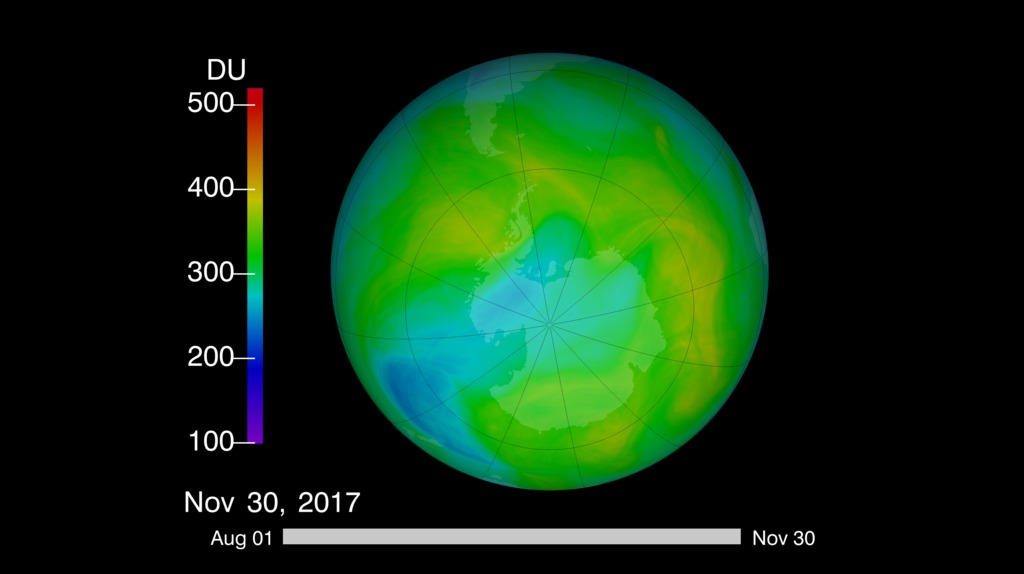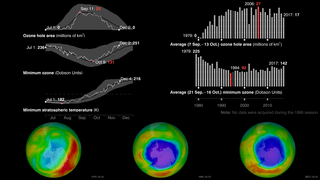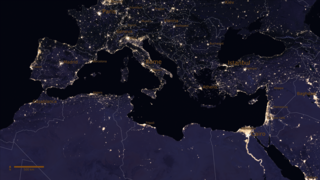Earth
ID: 30920

NASA scientists report the ozone hole over Antarctica reached an annual maximum size of on September 11, 2017. The Antarctic ozone hole is caused by manmade ozone-depleting chemicals and has been a feature of the atmosphere for more than 3 decades. Ozone protects the Earth's surface from harmful ultraviolet (UV) radiation from the sun. The UV index is a measure of the level of UV radiation. Values below 3 indicate low and safer levels while levels above 5 indicate high and more dangerous levels.
When the ozone hole first forms in August and September, the UV index is relatively low over the mid- to high latitudes due to the low sun angle. As the season progresses, the ozone hole becomes larger and extends into midlatitudes, passing over the tip of South America and over New Zealand. The sun angle is much higher and UV levels can reach dangerous levels. The UV index tracks closely with the area of low ozone. As the ozone hole disappears in late November, the UV index levels decrease from extreme levels to normal summer levels, which are still moderately high.
Ozone data are from the NASA Global Modeling and Assimilation Office's Modern Era Retrospective Analysis for Research and Applications 2 (MERRA-2) that uses observations from the Aura Ozone Monitoring Instrument (OMI). UV index data are from OMI and are shown once a day for local noon.

Total Ozone and UV, 2017

When the ozone hole first forms in August and September, the UV index is relatively low over the mid- to high latitudes due to the low sun angle. As the season progresses, the ozone hole becomes larger and extends into midlatitudes, passing over the tip of South America and over New Zealand. The sun angle is much higher and UV levels can reach dangerous levels. The UV index tracks closely with the area of low ozone. As the ozone hole disappears in late November, the UV index levels decrease from extreme levels to normal summer levels, which are still moderately high.
Ozone data are from the NASA Global Modeling and Assimilation Office's Modern Era Retrospective Analysis for Research and Applications 2 (MERRA-2) that uses observations from the Aura Ozone Monitoring Instrument (OMI). UV index data are from OMI and are shown once a day for local noon.

Related
For More Information
Credits
Paul Newman (NASA/GSFC): Lead Scientist
Eric Nash (SSAI): Scientist
Susan Strahan (USRA): Scientist
Natalya Kramarova (SSAI): Scientist
Nickolay Krotkov (NASA/GSFC): Scientist
Heather Hanson (GST): Writer
Marit Jentoft-Nilsen: Technical Support
Krzysztof Wargan (SSAI): Scientist
Eric Nash (SSAI): Scientist
Susan Strahan (USRA): Scientist
Natalya Kramarova (SSAI): Scientist
Nickolay Krotkov (NASA/GSFC): Scientist
Heather Hanson (GST): Writer
Marit Jentoft-Nilsen: Technical Support
Krzysztof Wargan (SSAI): Scientist
Please give credit for this item to:
NASA's Goddard Space Flight Center
NASA's Goddard Space Flight Center
Short URL to share this page:
https://svs.gsfc.nasa.gov/30920
Data Used: Note: While we identify the data sets used in these visualizations, we do not store any further details nor the data sets themselves on our site.
Keywords:
GCMD >> Earth Science >> Atmosphere >> Atmospheric Chemistry/Oxygen Compounds >> Ozone
GCMD >> Earth Science >> Atmosphere >> Atmospheric Radiation >> Ultraviolet Radiation
SVS >> Hyperwall
NASA Science >> Earth
GCMD keywords can be found on the Internet with the following citation: Olsen, L.M., G. Major, K. Shein, J. Scialdone, S. Ritz, T. Stevens, M. Morahan, A. Aleman, R. Vogel, S. Leicester, H. Weir, M. Meaux, S. Grebas, C.Solomon, M. Holland, T. Northcutt, R. A. Restrepo, R. Bilodeau, 2013. NASA/Global Change Master Directory (GCMD) Earth Science Keywords. Version 8.0.0.0.0
https://svs.gsfc.nasa.gov/30920
Data Used: Note: While we identify the data sets used in these visualizations, we do not store any further details nor the data sets themselves on our site.
Keywords:
GCMD >> Earth Science >> Atmosphere >> Atmospheric Chemistry/Oxygen Compounds >> Ozone
GCMD >> Earth Science >> Atmosphere >> Atmospheric Radiation >> Ultraviolet Radiation
SVS >> Hyperwall
NASA Science >> Earth
GCMD keywords can be found on the Internet with the following citation: Olsen, L.M., G. Major, K. Shein, J. Scialdone, S. Ritz, T. Stevens, M. Morahan, A. Aleman, R. Vogel, S. Leicester, H. Weir, M. Meaux, S. Grebas, C.Solomon, M. Holland, T. Northcutt, R. A. Restrepo, R. Bilodeau, 2013. NASA/Global Change Master Directory (GCMD) Earth Science Keywords. Version 8.0.0.0.0












